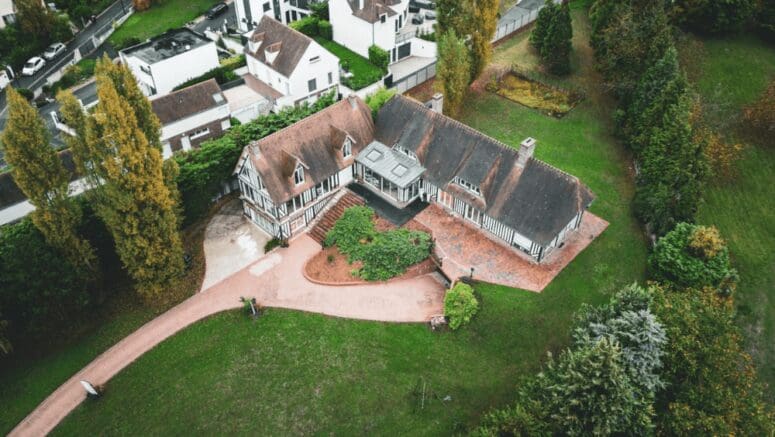How Old Is Your House? 11 Ways to Check Your Home’s Age
- Published on
- 9 min read
-
 Jennifer Schmidt, Contributing AuthorClose
Jennifer Schmidt, Contributing AuthorClose Jennifer Schmidt Contributing Author
Jennifer Schmidt Contributing AuthorJennifer Schmidt is a freelance writer based in Vancouver, Washington, who specializes in real estate, human resources, and technology. When not writing, you’ll find her scanning real estate listings for the latest housing trends and decorating ideas.
-
 Richard Haddad, Executive EditorClose
Richard Haddad, Executive EditorClose Richard Haddad Executive Editor
Richard Haddad Executive EditorRichard Haddad is the executive editor of HomeLight.com. He works with an experienced content team that oversees the company’s blog featuring in-depth articles about the home buying and selling process, homeownership news, home care and design tips, and related real estate trends. Previously, he served as an editor and content producer for World Company, Gannett, and Western News & Info, where he also served as news director and director of internet operations.
Whether your home is 25 or more than 100 years old, clues to its precise age often can be discovered with the right detective work. To help you uncover the secret of your home’s age, we talked to a top expert and researched the best resources you’ll need to answer that curious question, “How old is my house?”
Edward Kaminsky from Manhattan Beach, California, knows the best methods to find out the age of your home. In addition to our extensive research, we’ve compiled 11 methods to help you determine your home’s age.
“Age is a major factor because I can tell you even recently built homes, the quality of construction dramatically changes every five to seven years in the current market,” Kaminsky says.
1. Check your ownership documents
Buying a house requires lots of paperwork to be processed due to the legal requirements in your state. In your ownership documents, you usually will have a home inspection report that could show the history of who owned the home previously. If this information is not part of your documentation, an alternative option is to request a copy from the local recorder’s office.
2. Access your county website or assessor’s office
Many city or county websites will have an online parcel search feature. Generally, each property is assigned an assessor’s parcel number (APN). This unique identifier is assigned by the tax assessor to real property under its jurisdiction. The types of information that can be found for each address usually include tax assessments, property value, and when the house was built. Some cities or counties don’t have their information online, which means you’ll need to visit that office in person to find the records via the grantor-grantee index or tract index.
3. Search your home’s address online
Begin with your favorite search engine, such as Google, Bing, or Yahoo!, by typing in your home address. You’ll find that many real estate websites will show the year when your house was built. You can also find other websites that have additional information about property taxes, permitting, deeds, or selling a house with a lien. By doing some cross referencing of the various dates, you’ll discover what information is the most accurate.
Pro search tip: When searching for an address, one way to eliminate unrelated results is to place the core address within quotes. This would include placing other words like avenue, street, or road outside the quotation marks. For example, in the Google search bar, you might type, “123 Maple” Road.
4. Hire a building inspector to look at the home construction
When you hire a local building inspector, they could have access to previous building permit applications for your home that usually would indicate the year when it was first built. Also, examining the construction of your home can tell you when it likely was constructed. For example, a home that used knob and tube wiring was popular from 1880 to the 1940s. Flooring and nails have changed with different manufacturing processes through the decades as well. Also, sometimes cornerstones with date stamps can be found in the basement, or newspapers that served as early attic insulation can tell you approximately when a house was built.
5. Visit your community library
If you’re ready to hit the books or even the microfiche, your community library can be a great alternative for discovering old property information when other records can’t be found. Having a discussion with your librarian about the information within the library system and additional community resources could get you faster results.
6. Check your toilet
Ready to literally flush out the real age of your home? It might sound like a strange place to look, but toilets are fixtures that don’t get switched out very often. If the toilet is the original one that was installed when your house was built, you could find a date stamped inside the toilet tank or on the underside of the lid.
7. Reach out to the local historical society
Your local historical society could be a treasure trove of information as its function is to preserve the history of the town. The details for your home could be found within its records or maps to provide the entire chronicle of your home, including the year it was built.
8. Review fire insurance maps
If you can’t find the age of your home through traditional methods, fire insurance maps may be able to help you. These dated maps were originally used by fire insurance underwriters as a way to have a record of all the structures built in a particular area. Detailed maps often were color coded with a key of the building materials and their level of fire resistance.
9. Research the style of your home’s architecture
Every house has its own unique architecture. If you don’t have access to traditional records, starting with the style of the home could narrow down the era it was likely built. Be it neo-traditional, post war, or from the Gilded Age, each architectural style reflects a distinct period in history. Neighboring houses that are similar to your home also could help you determine the age. Along with architectural changes, building codes change over time, as Kaminsky explains about his market.
Not too long ago, wood-burning fireplaces were allowed, but you can’t build them anymore, Kaminsky says. “But if you get a home built prior to a specific year in Southern California, it’s possible it has a wood-burning fireplace. So, if that’s something that’s important to you, you know not to buy the newer homes; you have to buy an older home to be able to get a fireplace.”
10. Use a paid service like neighborwho.com
Using a paid service such as neighborwho.com and checkpeople.com can assist you if you can’t find the information elsewhere. Both websites offer a five-day trial for a nominal fee but if you don’t cancel during the trial period, you’ll be charged a higher amount.
Alternatively, an ad-supported resource website that may be helpful is tracemyhouse.com. In addition, FamilySearch.org is a free option that often has access to historical data for properties. Also, census.gov is another website where you can search various records to find older demographic information.
Your tax assessor records will show the year the home was built. To access tax records, it probably can be done online, but most local real estate agents have access to that information. And so you can call a local Realtor and they should be able to look it up for free.
11. Ask a local real estate agent
According to Kaminsky, having a local agent is one of the best options for getting the property information you need, as they usually have access to the tax assessor documents and a title insurance company.
“Your tax assessor records will show the year the home was built. To access tax records, it probably can be done online, but most local real estate agents have access to that information. And so you can call a local Realtor and they should be able to look it up for free.”
If you want a convenient option for finding a top local agent, HomeLight’s free Agent Match platform is a great way to search for the right person to help you with your home sale.
Why is it important to know when your house was built?
Knowing the age of your house and considering its present condition will tell you how well it has aged and if the previous owners were careful in maintaining it.
“The age certainly affects the value of the home, but it’s usually the current condition because you could have a home built in 1917, but it’s been fully updated. It doesn’t matter if it was built in 1917, if it’s been remodeled and structurally upgraded. So I think how it’s been maintained, and / or upgraded, affects the value more so than when the home was actually built,” Kaminsky says.
Other situations when knowing a home’s age is beneficial include:
- Preparing to sell your home
- Considering a renovation
- Getting homeowners insurance
- Curious about the home’s history
- Want to accurately determine the value
- For preventive maintenance measures
- Using the age as part of a marketing strategy
- Understanding if there are any hazards
In addition to lead paint, another potential hazard is asbestos, which can sometimes be found in heating ducts, tiles, siding, and ceiling materials.
Does the age of your home affect your home sale?
Satisfying your curiosity isn’t the only reason to pinpoint the age of your property, as often it will help you with insurance, remodeling projects, and even proving historical providence, which may increase the value.
Kaminsky describes a time he sold a property in Virginia for almost $18 million that was designed by former US President Thomas Jefferson.
“That age and that kind of history, it can enhance the salability of the home and, of course, affect the final sale price.”
While age is certainly one of the considerations in a home’s value, other qualities can also help determine the overall value by following the home appraisal model, including:
- Property features (size, condition, and materials)
- Improvements to the home (upgrades or additions)
- Location (proximity to top schools and parks)
- Market conditions (buyer’s or seller’s market and interest rates)
- Comparable property values (square footage and amenities)
If you want to get an initial ballpark assessment of your home’s current value, try using HomeLight’s free Home Value Estimator. This tool scans through public records and millions of real estate transactions to give you a real-world home value estimate in less than two minutes.
Conclusion: Takeaways for deducing the age of your home
As a home seller, when you solve the mystery of your home’s age, it can be helpful for your insurance policy, next renovation, or to market the property. Remember the following tips to help determine the correct age of your home, including:
- Review all the records: Ownership, county records, or historical data are great resources for uncovering the details of your home.
- Look for structural clues: Flooring, nails, or wiring can point the way to the history of your home, or peeking inside your toilet tank can reveal the date details.
- Get expert advice: A home inspector, librarian, or real estate expert can all give you clues about the history, architecture, and data to help you.
Besides your home’s age, if you’re curious to discover the right agent for your local home market, HomeLight’s free Agent Match platform is a great tool to use in finding a top-performing real estate agent in your market.
Header Image Source: (Miguel Picq / Unsplash)
- "How to Determine the Age of a Building," International Association of Certified Home Inspectors
- "Knob-and-Tube Wiring," International Association of Certified Home Inspectors
- "Using Fire Insurance Maps for Family History," The Family Heart
- "Architectural Styles: Residential," National Association of Realtors
- "All About Post-War Architecture," HGTV


